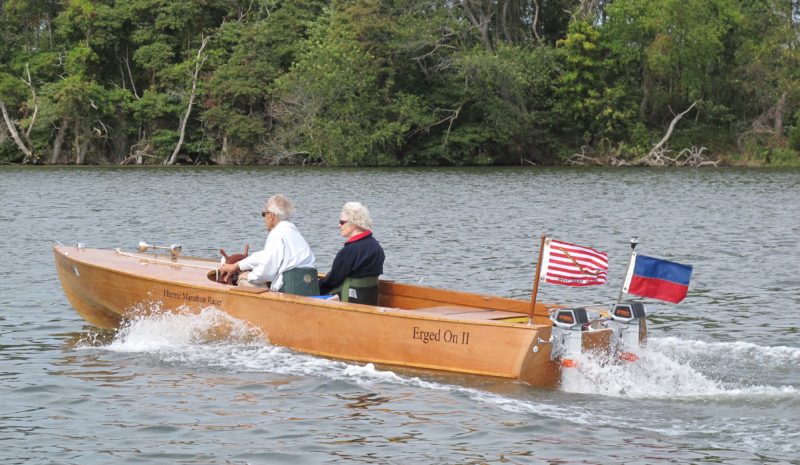 Ed Farinholt
Ed FarinholtWith trucker’s horn on the foredeck and the “Don’t Tread On Me” Navy jack flying at the stern, ERGED ON may be compensating for the absence of the intimidating noise that a gas outboard would produce.
Ned Farinholt of Winchester, Virginia, had a career as an electronics engineer, so it’s no surprise that he took an interest in electric boats. They had fallen out of favor since their beginnings in the middle of the 1800s but have been making a resurgence with the development of new technology in batteries and motors and a growing concern for the environment. In 1992, a group of enthusiasts formed the Electric Boat Association of America, dedicated to “the enjoyment and promotion of clean, quiet electric boating.”
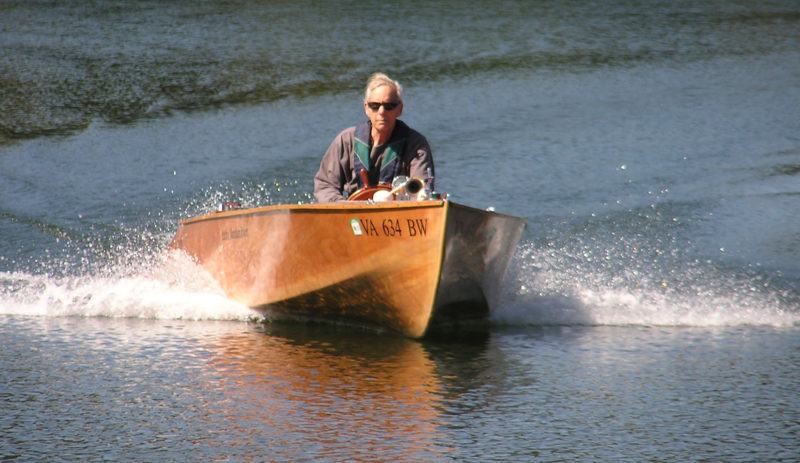 Ed Farinholt
Ed FarinholtWith just Ned aboard, ERGED ON II hits a top speed of 17 mph with the motors drawing a total of 10 kilowatts.
To encourage advancements in electric boats, the association created the Wye Island Challenge, a 24-mile-long electric-boat marathon that starts and finishes in St. Michaels, Maryland, and loops around Wye Island. The island is surrounded by estuaries and rather protected waters, but to get to the island racers have to cross 5 miles of open water and may encounter up to 2′ Chesapeake Bay chop.
Ned’s first entry in the race was in 2011 in a 15′ aluminum utility skiff. Ned had been keeping tabs on the development of lithium batteries for electric cars and chose lithium as his power source. All the other boats in that year’s race, whether using ready-made electric trolling motors, outboards and inboards, even gas outboards converted to electric power, were using lead-acid batteries, so his boat—ERGED ON—had a distinct weight advantage. He was the first racer to exceed the limits of hull speed and begin to plane.
“There was,” says Ned, “considerable teasing about my hot-rod approach at a gentlemen’s game. I resolved that next year that I would come back with a pretty boat.” His only boatbuilding experience had been making a plywood kit kayak with one of his grandchildren. He searched for plans for a boat he could build in plywood. To do well again in the race he needed a boat that could exceed hull speed. Other racers, working with the same idea, produced multihulls, long slender shells, and even hydrofoils. Ned decided upon a planing hull, the best option for his boatbuilding skills and the space he had in his shop. He found Charles Mower’s WHIZ, a skiff the well-known naval architect designed in 1926 for the Johnson Motor Company to complement their new 6-hp outboard.
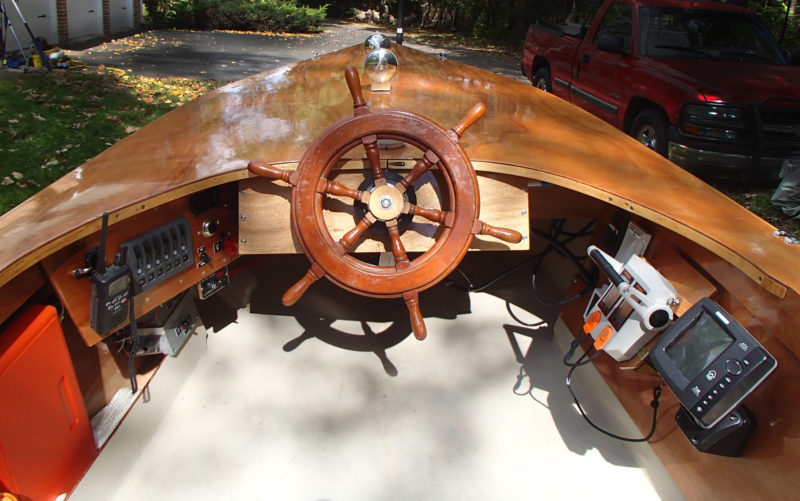 Ned Farinholt
Ned FarinholtERGED ON II is equipped with a handheld VHF radio, an electric bilge pump, dual motor controls and a depth finder.
Ned stretched the 16′ hull to 18′ 10″. He built the boat over molds, in the traditional manner, but used plywood and stitch-and-glue construction. There was too much twist in the bottom at the bow, so he had to use three strakes instead of a single panel to take the shape.
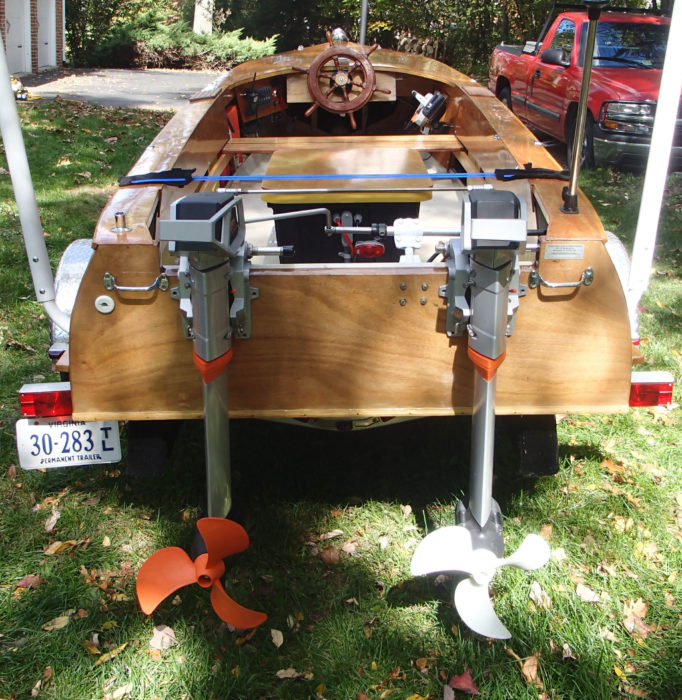 Ned Farinholt
Ned FarinholtThe boat that Charles Mower designed in 1926 was intended for a single 6-hp gas outboard. St A standard Torqeedo 4 motors are rated as 4 kW and the equivalent of an 8-hp gas outboard. Ned upgraded his motors to 6 kW.
Before decking the boat, he did sea trials, using used a Torqeedo 4 electric outboard. Consuming 4.5 kW of power, the motor brought the boat up to 12 mph. That more than met his expectations, and Ned later entered the finished ERGED ON II in the 2012 Wye Island Challenge. He won but didn’t do as well as he had expected. The motor began to overheat and automatically cut back to 3.5 kW to protect the electrical system. Ned solved the problem by adding a second Torqeedo 4 and another bank of batteries. That stood him in good stead in the 2013 race until he cut a corner in the Miles River, clipped an oyster reef, and knocked out an engine. With the remaining engine he was able to finish in second place. The following year he gave the shoals a wide berth and won the race, in spite of having the extra weight of a passenger aboard.
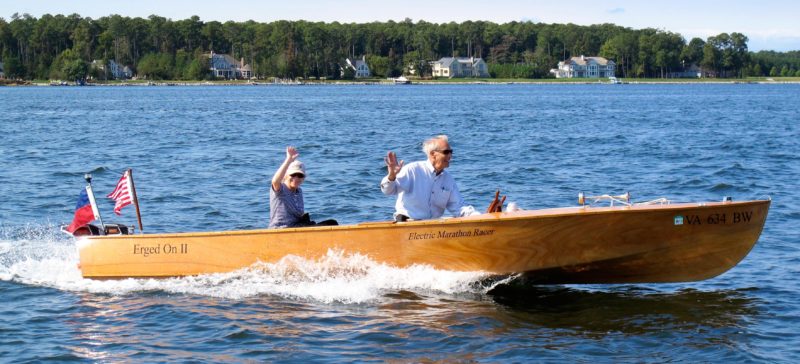 Pegg Bliss
Pegg BlissWith Ned and Marilyn aboard, ERGED ON II tops out at 15 miles per hour.
In 2015 conditions on the race course were roughened up by a 15-knot wind, and only 6 of the 11 boats that started finished the race. Ned, with his wife Marilyn aboard, broke the two-hour barrier, but he wasn’t alone. John Todd, in MISS WYE, his slender 20′ racing hull, also broke the two-hour barrier, finishing 11 minutes ahead of ERGED ON II. Ned may be back this year, pushing for more quiet speed.![]()
Have you recently launched a boat? Please email us. We’d like to hear about it and share your story with other Small Boats Monthly readers.
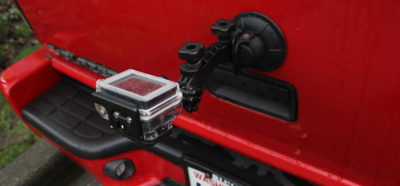
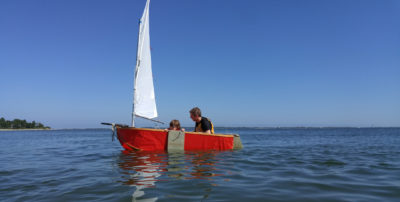
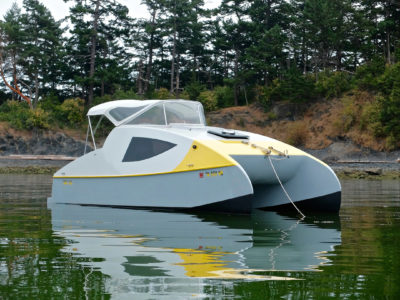
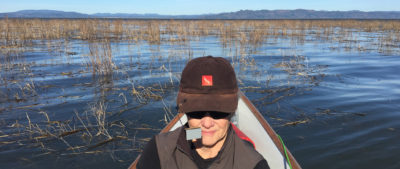
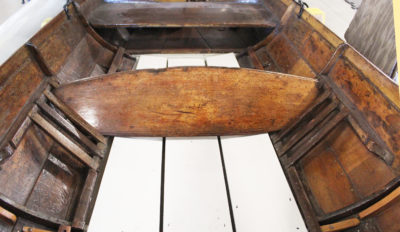
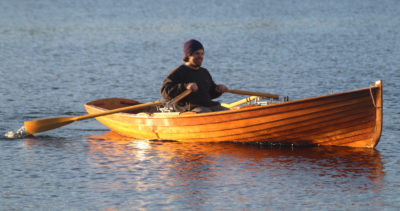
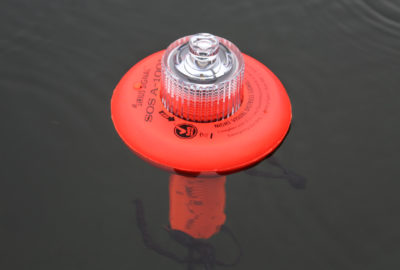
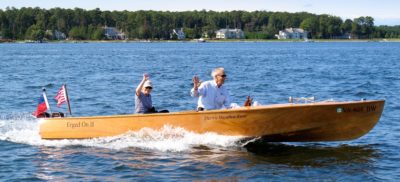
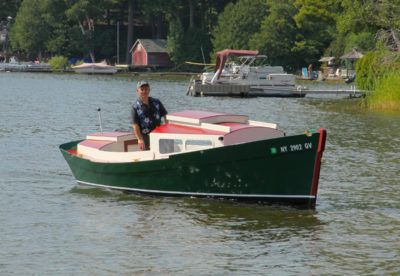
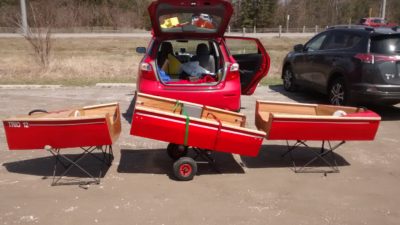
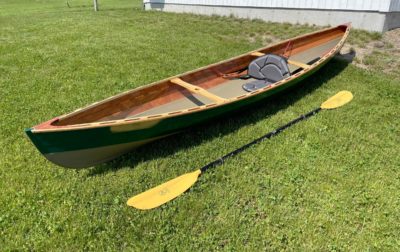

I wish Mr. Farinholt had shared a few more of the technical details of his electric propulsion system such as battery capacity, amps drawn at certain speeds, the props’ diameter and pitch, and whether or not he opted for opposite rotating props.
Glad to share tech info. The batteries are LiFePO4 prismatic cells, two banks, 160AH each, 60 volts. The boat with pilot is about 1000 lbs. The props are the Torqeedo high-performance ones, about 13″ diameter. The motors are not opposite rotating—Torqeedo did not offer that option. The speed vs power curve can be approximated by S=6+1.3P where S is in mph and P is in total KW input. One kw goes 5 mph and 8 kw goes about 16 mph. The battery banks hold at about 60 volts so you can calculate amps from power drain.
Ned, wonderful project and there is probably more speed yet to be found. Looking at the photo, I suspect that speed is limited by having what looks like excessive frictional resistance. For this boat at 16mph, a higher hull trim angle to get more surface area out of the water should make for more speed. One way to go there is to move weight further aft. Moving weight too far aft can cause porpoising but looking at the photo, you should be able to move weigh a significant amount further aft with no problem. A trim angle of 4 to 5 degrees should be ideal for speed in this hull. Other methods for increasing the trim angle would probably involve modification to the hull bottom.